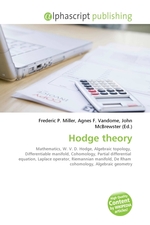Hodge theory
Frederic P. Miller, Agnes F. Vandome, John McBrewster
бумажная книга
In mathematics, Hodge theory, named after W. V. D. Hodge, is one aspect of the study of the algebraic topology of a smooth manifold M. More specifically, it works out the consequences for the cohomology groups of M, with real coefficients, of the partial differential equation theory of generalised Laplacian operators associated to a Riemannian metric on M. It was developed by W. V. D. Hodge in the 1930s as an extension of de Rham cohomology, and has major applications on three levels: Riemannian manifolds, Kahler manifolds, algebraic geometry of complex projective varieties, and even more broadly, motives. In the initial development, M was taken to be a closed manifold (that is, compact and without boundary). On all three levels the theory was very influential on subsequent work, being taken up by Kunihiko Kodaira (in Japan and later, partly under the influence of Hermann Weyl, at Princeton) and many others subsequently.
Данное издание не является оригинальным. Книга печатается по технологии принт-он-деманд после получения заказа.


